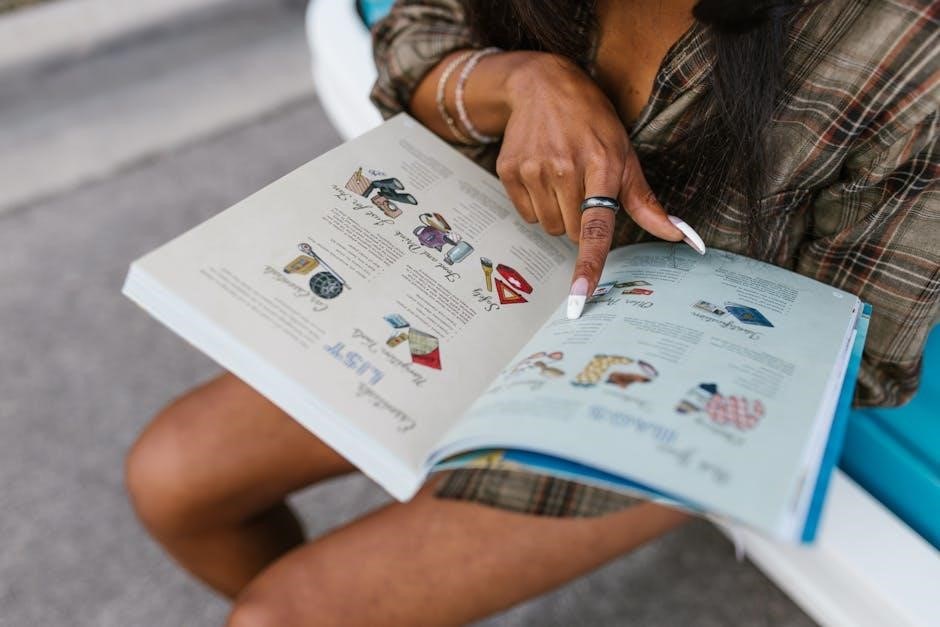The Bedford Book of Genres serves as a comprehensive guide to understanding and analyzing literary genres, offering insights into their definitions, historical contexts, and evolutionary trajectories.
1.1 Overview of the Bedford Book of Genres
The Bedford Book of Genres is a comprehensive guide designed to help readers and students explore the diverse world of literary genres. It provides a detailed examination of various genres, from narrative and poetic to dramatic and non-fiction, offering critical introductions and practical insights. The text emphasizes understanding the historical and cultural contexts of genres, as well as their evolution over time; It also includes key features such as examples, analysis, and writing guidance, making it a valuable resource for both analysis and composition. By covering a wide range of genres, the Bedford Book of Genres serves as an essential tool for anyone seeking to deepen their understanding of literary forms and their significance.
1.2 Importance of Genre Studies in Literature
Genre studies are essential for understanding the structure, themes, and conventions of literary works. By examining genres, readers can identify patterns and expectations that shape how authors write and audiences interpret texts. Genres serve as frameworks for communication, guiding both creation and reception. They reflect cultural, historical, and social contexts, offering insights into the values and beliefs of different eras and communities. Genre studies also enhance critical thinking by encouraging readers to analyze how works conform to or challenge genre norms. This understanding fosters deeper engagement with literature and improves writing skills by providing models for expression. Ultimately, genre studies bridge the gap between literary theory and practical analysis, enriching the study of literature as a whole.
1.3 Key Features of the Bedford Book of Genres
The Bedford Book of Genres is a comprehensive resource that explores various literary genres, providing detailed analyses and practical examples. It includes essays, stories, poems, and dramas, each accompanied by commentary to illustrate genre conventions. The text offers tools for identifying and analyzing genres, such as checklists and guidelines for reading and writing within specific genres. It also covers hybrid and emerging genres, reflecting the diversity of literary expression. The book is designed to help students and instructors understand how genres shape meaning and influence writing. With its wide-ranging scope and accessible approach, it serves as an invaluable guide for studying and teaching literary genres.

Understanding Literary Genres
Literary genres categorize works based on style, form, and content, providing a framework for understanding shared conventions and reader expectations across different types of writing.
2.1 Definition and Scope of Literary Genres
Literary genres are categories that classify works based on their style, form, and content, providing a shared understanding of conventions and expectations for writers and readers alike.
The scope of literary genres is vast, encompassing both traditional forms like poetry, prose, and drama, as well as emerging hybrid genres that blend boundaries and challenge conventions.
Genres evolve over time, reflecting cultural, historical, and social changes, making them dynamic frameworks for interpreting and analyzing literary works.
Understanding genre helps readers identify themes, structures, and purposes, while writers use genres to communicate effectively and connect with their audiences.
The study of genres is essential for developing critical thinking and analytical skills, as it reveals how literature reflects and shapes human experiences across different contexts.
2.2 Major Categories of Literary Genres
Literary genres can be broadly categorized into narrative, poetic, dramatic, and non-fiction forms, each with distinct conventions and purposes.
- Narrative genres include novels, short stories, and memoirs, focusing on storytelling and character development.
- Poetic genres, such as sonnets and free verse, emphasize language, rhythm, and emotional expression.
- Dramatic genres, like tragedy and comedy, are designed for performance, relying on dialogue and action.
- Non-fiction genres, including essays and biographies, prioritize factual information and analysis.
These categories provide a framework for understanding the diversity of literary works and their unique characteristics.
2.3 The Role of Genre in Shaping Literary Works
Genre serves as a framework that guides authors in organizing themes, styles, and narrative structures, influencing how stories are told and received. It establishes reader expectations, enabling effective communication between writer and audience. By adhering to genre conventions, such as specific tropes or stylistic elements, authors can explore ideas within a recognizable context. Genre also inspires creativity, as writers often innovate within established boundaries. For example, blending genres like tragedy and comedy creates unique narratives. Over time, genres evolve, reflecting cultural shifts and new artistic visions. This adaptability ensures literature remains relevant, allowing genres to continue shaping the way stories are crafted and interpreted.

Narrative Genres
Narrative genres explore human experiences through storytelling, encompassing novels, short stories, memoirs, and autobiographies. These forms captivate audiences with their unique structures and emotional depth, shaping literary expression.
3.1 The Novel as a Narrative Genre
The novel, a cornerstone of narrative genres, offers extended, detailed storytelling. It explores complex themes, character development, and social contexts, evolving from epistolary forms to contemporary styles. Novels often blend realism and imagination, providing deep insights into human experiences. Their structured narratives, with clear beginnings, middles, and ends, captivate readers emotionally and intellectually. The Bedford Book of Genres highlights the novel’s versatility, from classical works like Don Quixote to modern experiments in form and language. This genre’s enduring popularity lies in its ability to reflect societal changes and universal truths, making it a vital part of literary studies and creative expression.
3.2 Short Story: Structure and Technique
The short story, a concise narrative form, relies on focused structure and precise technique to convey meaning. Typically featuring a single plot, limited characters, and a clear beginning, middle, and end, short stories emphasize brevity and impact. Techniques like dialogue, symbolism, and imagery are used sparingly but effectively to create depth; Conflict and climax are central, often resolving in a moment of revelation. The Bedford Book of Genres explores how authors master these elements, using examples to illustrate how short stories balance economy of language with emotional resonance. This genre’s compactness challenges writers to innovate, making it a cornerstone of literary study and creative practice.
3.3 Memoir and Autobiography: Personal Narratives
Memoirs and autobiographies are personal narratives that explore an individual’s life experiences, offering intimate reflections and insights. While autobiographies typically cover a person’s entire life, memoirs focus on specific events or themes. Both genres emphasize authenticity and emotional depth, often blending storytelling techniques with factual accounts. The Bedford Book of Genres discusses how these forms use vivid descriptions, dialogue, and introspection to engage readers. They also serve as tools for self-discovery, allowing authors to process their journeys and share universal truths. By examining these genres, readers gain insight into personal and historical contexts, making memoirs and autobiographies powerful vehicles for connection and understanding.

Poetic Genres
Poetic genres encompass a wide array of forms, each with unique structures and purposes, from lyric poetry’s personal expressions to narrative poetry’s storytelling and dramatic poetry’s dialogue.
4.1 Lyric Poetry: Forms and Functions
Lyrical poetry, a highly personal and emotional form, emphasizes the poet’s inner world and feelings. It often employs first-person narration, creating intimacy with the reader.
Common forms include sonnets, odes, and elegies, each with distinct structures and purposes. Imagery, rhythm, and symbolism are central to conveying complex emotions and ideas.
The function of lyric poetry is to express individual experiences, thoughts, and emotions, offering readers a window into the poet’s psyche. It often explores themes of love, nature, and existential questions.
Through its concise and expressive language, lyric poetry bridges the personal and universal, fostering a deep connection with its audience. Its versatility allows for exploration of diverse themes and styles.
4.2 Narrative Poetry: Storytelling in Verse
Narrative poetry is a genre that tells a story, often with a clear beginning, middle, and end. It can be short or lengthy, such as epics like The Iliad or The Odyssey.
Key elements include plot, characters, and setting, which create a narrative arc. Poets use language, dialogue, and descriptive details to convey the story dynamically.
This form serves as a vessel for cultural, historical, or personal tales, making it a timeless medium for storytelling. Narrative poetry often explores themes of adventure, morality, or human emotion.
Through rhyme, rhythm, and imagery, poets enhance the emotional depth of their narratives, engaging readers and preserving stories across generations. This genre is essential for understanding literary storytelling techniques.
4.3 Dramatic Poetry: Performance and Dialogue
Dramatic poetry is crafted for performance, emphasizing dialogue and action to convey emotion and narrative. It often resembles theater, with characters speaking directly, creating dynamic interactions.
Stage directions and descriptive language guide performers, enhancing the dramatic effect. This genre thrives on oral tradition, engaging audiences through spoken word and communal storytelling.
Dramatic poetry blends poetic devices with theatrical elements, making it a powerful medium for expression. Its focus on dialogue and performance sets it apart from other poetic forms, fostering emotional resonance and immediacy.

Dramatic Genres
Dramatic genres explore human struggles, societal issues, and emotional depth through performance. They rely on dialogue, stage directions, and audience engagement to convey themes and narratives effectively.
5.1 Tragedy: Themes and Conventions
Tragedy is a dramatic genre that explores the downward trajectory of a protagonist, often due to a tragic flaw or external circumstances. It delves into themes of suffering, moral dilemmas, and the human condition. Common conventions include the tragic hero, whose downfall evokes pity and fear, and the concept of catharsis, where audiences experience emotional purging. Tragic plays often examine fate versus free will, hubris, and the inevitability of destiny. The structure typically follows a progression from exposition to resolution, with a focus on dramatic tension and climax. Tragedy also employs devices like tragic irony and the chorus to enhance narrative depth and thematic resonance.
5.2 Comedy: Humor and Satire in Drama
Comedy is a dramatic genre characterized by humor, wit, and lightheartedness, often resolving in a harmonious conclusion. It employs satire to critique societal norms, politics, or cultural issues through irony, exaggeration, and ridicule. Comedies frequently feature misunderstandings, farcical situations, and stock characters like the fool or trickster. Satire, a subset of comedy, uses humor to expose vices or follies, encouraging change through laughter. The genre relies on dialogue, timing, and physical comedy to engage audiences. By addressing serious themes in an amusing manner, comedy provides both entertainment and social commentary, making it a versatile and enduring form of dramatic expression.
5.3 Drama as Social Commentary
Drama often serves as a powerful medium for social commentary, addressing issues like inequality, injustice, and moral dilemmas. Through realistic portrayals of human experiences, dramas reflect societal concerns, provoke thought, and inspire change. Playwrights use dialogue, character development, and plot structures to highlight contemporary problems, fostering empathy and awareness among audiences. This genre frequently incorporates themes of identity, power dynamics, and ethical conflicts, encouraging viewers to critically examine their own beliefs and the world around them. By representing diverse perspectives, drama acts as a mirror to society, challenging norms and sparking conversations about pressing issues.

Non-Fiction Genres
Non-fiction genres explore real-world topics, blending factual accuracy with narrative techniques. They include essays, biographies, and historical writing, aiming to inform, persuade, or reflect on reality.
6.1 Essay: Forms and Purposes
The essay is a versatile non-fiction genre that expresses personal opinions, analyses, or critiques. It often blends narrative and expository elements, making it adaptable for various purposes like persuasion, reflection, or education. Essays can take many forms, including narrative, descriptive, expository, and argumentative styles. They are characterized by a clear structure, typically featuring an introduction, body paragraphs, and a conclusion. The essay’s flexibility allows writers to explore diverse subjects, from personal experiences to complex societal issues. Its primary purpose is to engage readers, provoke thought, and convey ideas effectively. Essays are widely used in academia and beyond, making them a cornerstone of non-fiction writing.
6.2 Biography: Life Writing
Biography is a non-fiction genre that delves into the detailed account of a person’s life, highlighting their experiences, achievements, and challenges. It aims to capture the essence of an individual’s journey, often providing historical and cultural context. Biographies can be written in various styles, from formal and scholarly to informal and narrative-driven. They serve to educate, inspire, and offer insights into the human condition. Biographical writing requires thorough research, including interviews, documents, and other sources. The genre not only preserves legacies but also allows readers to connect with real-life stories, making it a vital form of life writing. Biographies often explore themes of identity, resilience, and societal impact.
6.3 Historical Writing: Narrative and Analysis
Historical writing combines narrative storytelling with analytical insights to explore past events, people, and cultures. It aims to reconstruct history through meticulous research, using primary sources like documents, artifacts, and testimonies. This genre often blends descriptive storytelling with critical analysis, providing context and interpreting historical significance. Historical writing can take various forms, from academic studies to engaging narratives, making history accessible to diverse audiences. The challenge lies in presenting complex information clearly while maintaining objectivity. Effective historical writing not only informs but also invites readers to reflect on the past and its relevance to the present. It bridges the gap between memory and understanding, offering a deeper appreciation of historical events and their enduring impact.

Hybrid and Emerging Genres
Hybrid and emerging genres blend traditional forms with innovative styles, creating unique narrative spaces. They challenge conventions, fostering creativity and reflecting contemporary cultural shifts and technological advancements.
7.1 Magical Realism: Blending Fantasy and Reality
Magical realism masterfully combines realistic narrative with fantastical elements, creating a unique literary experience. Authors like Gabriel García Márquez and Isabel Allende popularized this genre, which often explores cultural and emotional depth. By integrating the extraordinary into everyday life, magical realism challenges readers to question reality and its perceptions. The genre’s strength lies in its ability to evoke both the familiar and the surreal, fostering a deeper connection to human experiences. This blending of worlds allows for rich, layered storytelling that resonates emotionally and intellectually, making magical realism a powerful tool for exploring complex themes and societal issues in a captivating manner.
7.2 Graphic Novels: Visual Storytelling
Graphic novels blend visual and textual narratives to create immersive storytelling experiences. This genre has evolved from traditional comics, offering complex, layered narratives that explore themes like identity, history, and social issues. Works such as Maus and Persepolis exemplify how graphic novels can convey deep emotional and cultural resonance. The medium’s unique combination of art and text allows readers to engage with stories in ways that pure prose cannot. Graphic novels often challenge conventional storytelling norms, appealing to diverse audiences and fostering a dynamic interplay between visual and literary elements. This versatility has made the genre a significant part of contemporary literature and academic study.
7.3 Digital Genres: Hypertext and Interactive Narratives
Digital genres like hypertext and interactive narratives represent a dynamic evolution in storytelling, leveraging technology to create immersive, non-linear experiences. Hypertext allows readers to navigate multiple paths within a story, while interactive narratives engage users through choices that shape outcomes. These forms challenge traditional narrative structures, offering unique opportunities for creative expression. Platforms like Twine have popularized interactive fiction, enabling authors to craft branching stories. Digital genres also blur the line between reader and author, fostering collaboration and experimentation. As technology advances, these genres continue to redefine how stories are told and consumed, offering limitless possibilities for innovation in literature and beyond. The rise of digital genres underscores the adaptability of storytelling in the modern age.

Analyzing Genres
Analyzing genres involves identifying conventions, themes, and structures, while exploring how they shape meaning. This process helps uncover the cultural and historical contexts of literary works.
8.1 Identifying Genre Conventions
Identifying genre conventions involves recognizing the typical elements, structures, and techniques that define a particular genre. These conventions, such as narrative patterns, character archetypes, or thematic motifs, help establish reader expectations and shape the boundaries of a genre. By analyzing these elements, readers can better understand how genres function and evolve. For example, romance novels often follow a predictable arc of conflict and resolution, while science fiction frequently explores futuristic or speculative themes. Understanding these conventions allows for a deeper appreciation of how genres communicate meaning and reflect cultural values. Effective identification of genre conventions also enables writers to either adhere to or subvert these expectations, creating innovative works within or across genres.
8.2 Genre Theory and Criticism
Genre theory and criticism explore how genres function as cultural and literary categories, shaping both creative works and reader expectations. Scholars analyze genres to understand their historical evolution, thematic concerns, and stylistic conventions. Critical approaches often examine how genres reflect societal values or challenge them, offering insights into power dynamics and cultural identity. By studying genre theory, readers gain a deeper understanding of how texts communicate meaning and how genres adapt over time. This analytical framework also helps critics evaluate how authors conform to or subvert genre norms, highlighting the interplay between tradition and innovation in literature. Genre criticism thus enriches our appreciation of literary diversity and complexity.
8.3 Subverting Genre Expectations
Subverting genre expectations involves challenging conventional norms and audience anticipations, often to create fresh perspectives or provoke thought. Authors achieve this by blending genres, introducing unexpected twists, or reinterpreting traditional themes. This approach can lead to innovative storytelling and thematic depth, as seen in works that mix horror with comedy or romance with science fiction. By defying genre boundaries, writers encourage readers to question assumptions and engage more critically with the material. Subversion not only redefines genre limitations but also reflects changing cultural values and artistic innovation, making it a powerful tool for exploring new ideas and expanding literary possibilities.

Teaching and Learning Genres
Teaching and learning genres involves developing critical thinking, communication skills, and digital literacy through interactive and collaborative approaches, fostering creativity and analytical understanding of genre conventions and evolution.
9.1 Pedagogical Approaches to Genre Studies
Pedagogical approaches to genre studies emphasize active learning, critical thinking, and creativity. Educators use scaffolded instruction, modeling, and guided practice to help students understand genre conventions. Differentiated instruction caters to diverse learning styles, while project-based learning encourages hands-on exploration. Technology integration, such as digital workshops and multimedia presentations, enhances engagement. Formative assessments, like peer reviews and reflective journals, provide ongoing feedback. Collaborative discussions and debates foster deeper understanding of genre evolution and cultural contexts. By connecting genres to real-world applications, educators prepare students to navigate complex literary and digital landscapes effectively.
9.2 Assignments and Activities for Genre Analysis
Assignments and activities for genre analysis are designed to deepen students’ understanding of literary and non-literary genres. Common tasks include analytical essays, where students identify and explain genre conventions in selected texts. Group projects encourage collaborative analysis, such as creating presentations that compare genres across different cultures or historical periods. Multimedia activities, like designing infographics or videos, help visualize genre elements. Workshops on close reading and critical thinking enhance students’ ability to interpret complex texts. Additionally, reflective writing assignments, such as genre-inspired creative writing, allow students to apply their knowledge practically. These activities foster critical thinking, creativity, and a nuanced understanding of genre roles in shaping meaning.
9.3 Assessing Genre Understanding in Students
Assessing genre understanding in students involves evaluating their ability to identify, analyze, and apply genre conventions. Instructors use various methods, such as analytical essays, quizzes, and group projects, to gauge comprehension. Assignments like genre-inspired creative writing or comparative analyses of texts from different genres provide insights into students’ grasp of genre-specific elements. Rubrics are often employed to ensure fair and consistent grading, focusing on criteria like genre recognition, critical thinking, and application of theoretical concepts. Additionally, peer reviews and reflective writing assignments encourage students to articulate their understanding and engage with feedback. Regular formative assessments, such as in-class discussions or online quizzes, help track progress and identify areas for further instruction.

The Future of Genres in a Digital Age
The digital age is reshaping genres through hypertext narratives, interactive storytelling, and multimedia integration, offering new ways to engage audiences and blur traditional genre boundaries.
10.1 Evolution of Genres in Digital Media
Digital media has transformed traditional genres, giving rise to new forms like hypertext narratives and interactive storytelling. These formats allow readers to engage dynamically, blurring boundaries between genres. The internet enables global sharing of content, fostering diverse storytelling styles. Digital tools like search queries and multimedia integration have redefined how genres evolve. For example, graphic novels and digital poetry now incorporate visuals and sound, enhancing reader interaction. This evolution challenges conventional genre classifications, prompting scholars to adapt their analytical frameworks. As technology advances, genres continue to merge and innovate, reflecting the dynamic nature of digital communication and creativity.
10.2 Impact of Technology on Genre Forms
Technology has profoundly influenced genre forms, enabling new modes of expression and interaction. Digital tools facilitate hybrid genres, blending traditional forms with multimedia elements. E-books, for instance, enhance readability with interactive features, while hypertext narratives allow nonlinear storytelling. Social media platforms foster collaborative content creation, democratizing genre development. Search engines and databases enable efficient research, aiding genre analysis. Moreover, technology promotes global dissemination of genre-based works, diversifying audiences and inspiring cross-cultural adaptations. These advancements challenge conventional genre boundaries, encouraging innovation in both creative and analytical practices. As a result, technology not only transforms how genres are consumed but also redefines their very essence in the digital age.
10.3 Adapting Genre Studies for the Digital Classroom
Adapting genre studies for the digital classroom involves integrating technology to enhance engagement and accessibility. Digital platforms allow students to explore genres through multimedia resources, such as e-books, podcasts, and interactive websites. Online discussions and collaborative tools foster deeper analysis and shared learning experiences. Educators can utilize digital databases and search engines to provide diverse textual examples, enabling students to compare and contrast genres globally. Additionally, digital classrooms support personalized learning through adaptive software and real-time feedback. By leveraging these tools, genre studies become more dynamic, preparing students to navigate and contribute to the evolving literary landscape in the digital age.
